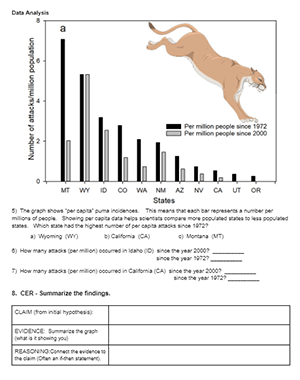
Students explore how wildlife management in some states allows for the hunting of cougars (pumas). States hope to reduce deadly encounters with the cats by using hunting to limit the number of animals. Does this tactic work? Data compares states that allows sport hunting to a state that does not allow it, California.
The data analysis is based on a publication from PLOS One. I don’t give students the whole article, but instead focus on one section. Students read the background of sport hunting and suggest a hypothesis for the states using that method to reduce puma attacks.
I encourage students to analyze graphs using the I2 strategy. For example, when they examine the graph showing puma attacks, students highlight “what they see.” Then for each annotation, they make notes about “what it means.”
For the unit on ecology, I like to incorporate lessons on wildlife management. Freshman students seem to engage with material when cats and dogs are involved. Plus, everyone loves to talk about wild animals and when they encounter humans. You can even start with watching a video showing a human – cougar encounter, there are several videos online. Another way to “hook” students is to share articles about cat attacks.
Data Analysis Activity
First, students propose a hypothesis regarding puma and human encounters. There are two versions of the worksheet. In the “bee” version, students choose from a list of hypotheses. The second version has the questions open-ended.
Then they use the data (graph) to determine if trophy hunting really does reduce deadly encounters between large cats and people. Ten states are shown on the graph that allow trophy hunting, which is compared to California, which bans the practice. Data shows number of attacks per million (per capita) for comparison between the states. If you are doing this activity in class with students, there are many places to pause and discuss.
Finally, they complete a CER (claim, evidence, reasoning) that summarizes the data. Ideally, students should discover that in places that hunt the cats, there is no evidence that this reduces attacks. There may be several other factors involved in the data, and they can trigger some interesting class discussions. For example, why would Montana have so many more attacks than Utah or Oregon? This is a great time to discuss the limitations of data!
As a follow up activity, you can provide them with a graphic (included on the last page) which details what you should do if you encounter a large predator. Wildlife experts caution that you should not run!

